Abstract
We evaluated the interaction of [3H]1,25(OH)2D3 with skin fibroblasts cultured from normal subjects or from affected members of six kindreds with rickets and resistance to 1-alpha, 25(OH)2D [1,25(OH)2D]. We analyzed two aspects of the radioligand interaction; nuclear uptake with dispersed, intact cells at 37 degrees C and binding at 0 degrees C with soluble extract ("cytosol") prepared from cells disrupted in buffer containing 300 mM KCl and 10 mM sodium molybdate. With normal fibroblasts the affinity and capacity of nuclear uptake of [3H]1,25(OH)2D3 were 0.5 nM and 10,300 sites per cell, respectively; for binding with cytosol these were 0.13 nM and 8,900 sites per cell, respectively. The following four patterns of interaction with [3H]1,25(OH)2D3 were observed with cells cultured from affected patients: (a) two kindreds; cytosol binding and whole-cell nuclear uptake both unmeasurable; (b) one kindred, decreased capacity and normal affinity both for binding in cytosol and for nuclear uptake in whole cells; (c) two kindreds, normal or nearly normal capacity and affinity of binding in cytosol but unmeasurable whole-cell nuclear uptake; and (d) one kindred, normal capacity and affinity of both cytosol binding and whole-cell nuclear uptake. In all cases where the radioligand bound with high affinity in nucleus or cytosol, the nucleus- or cytosol-associated radioligand exhibited normal sedimentation velocity on sucrose density gradients. When two kindreds exhibited similar patterns (i.e. pattern a or c) with the analyses of cultured fibroblasts, clinical features in affected members suggested that the underlying genetic defects were not identical. In conclusion: (a) Fibroblasts cultured from human skin manifest nuclear uptake and cytosol binding of [3H]1,25(OH)2D3 that is an expression of the genes determining these processes in target tissues. (b) Based upon data from clinical evaluations and from analyses of cultured fibroblasts, severe resistance to 1,25(OH)2D resulted from five or six distinct genetic mutations in six kindreds.
Full text
PDF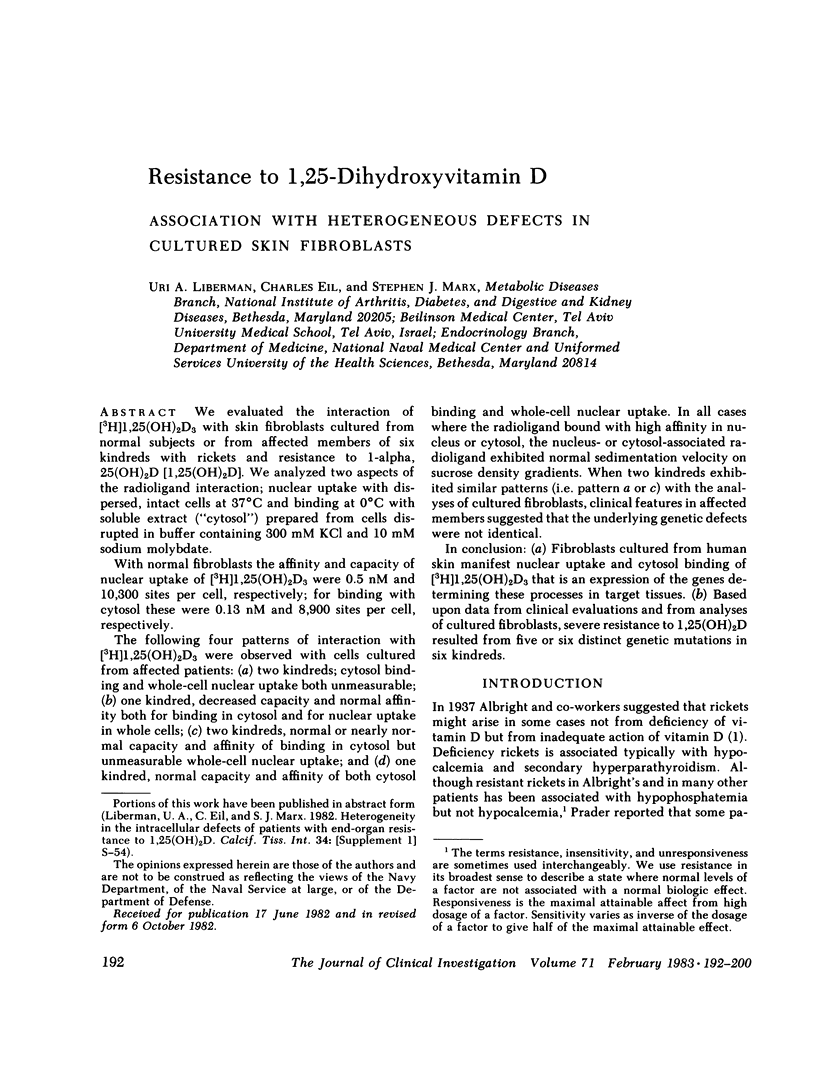
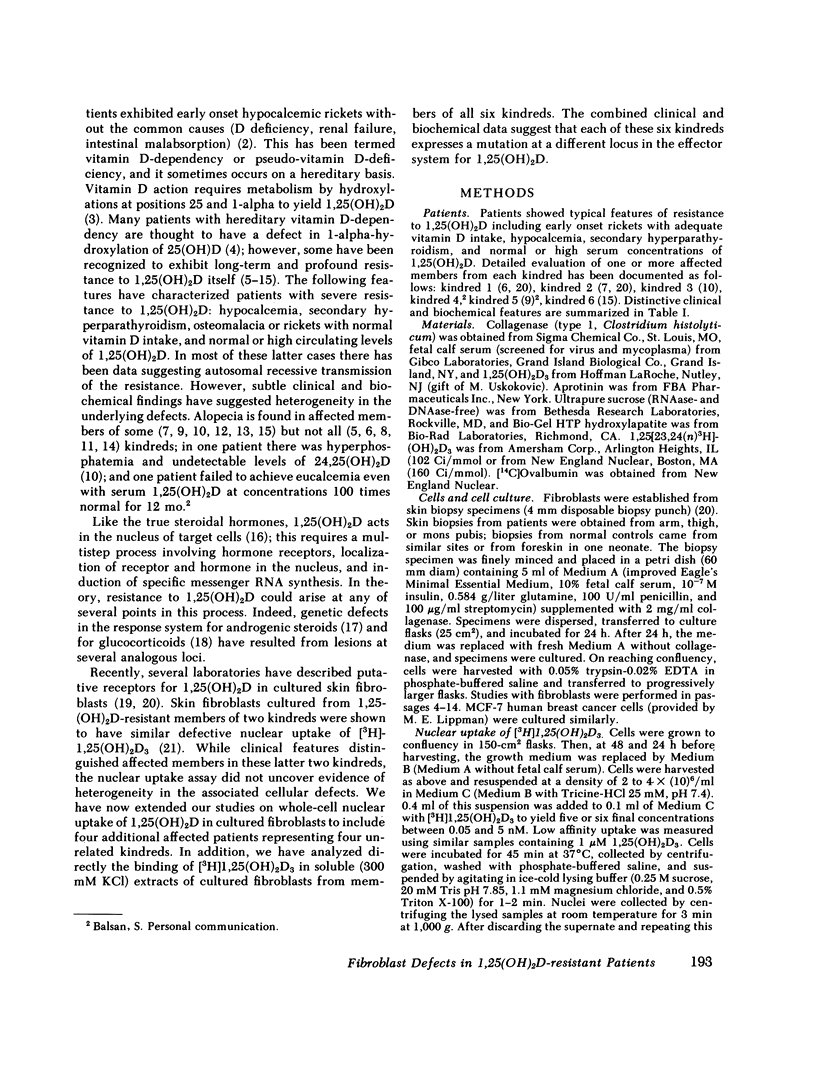
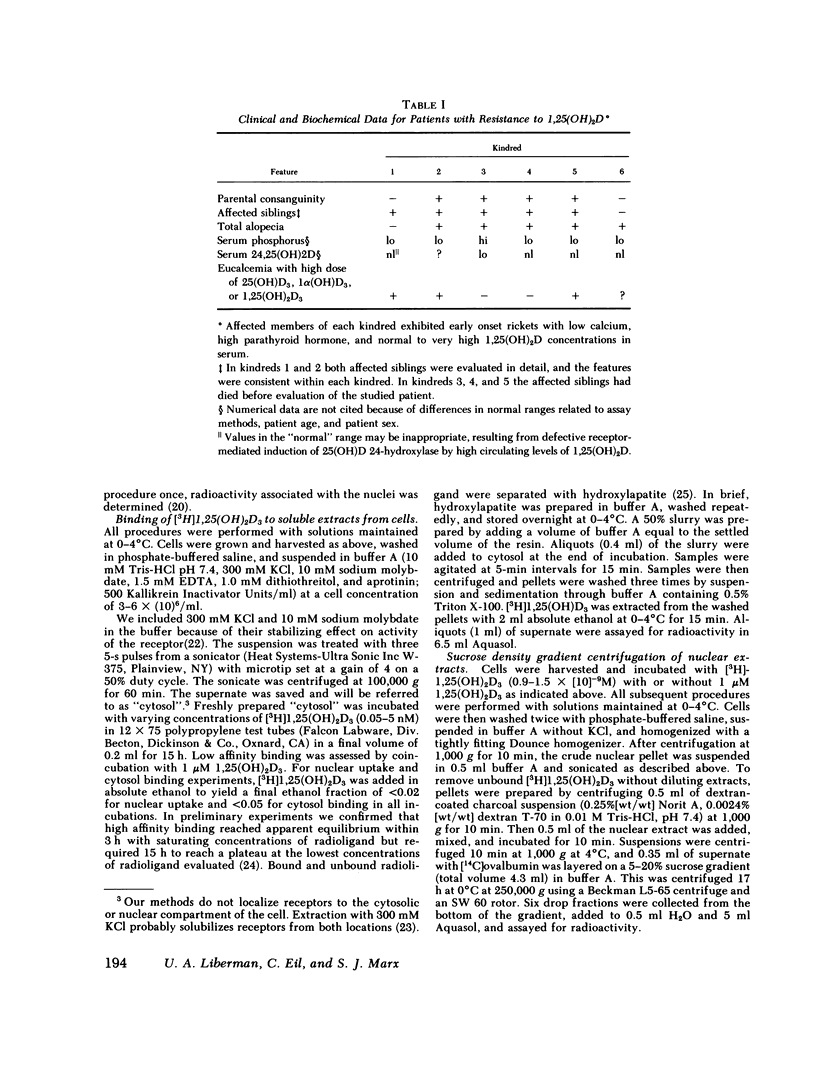
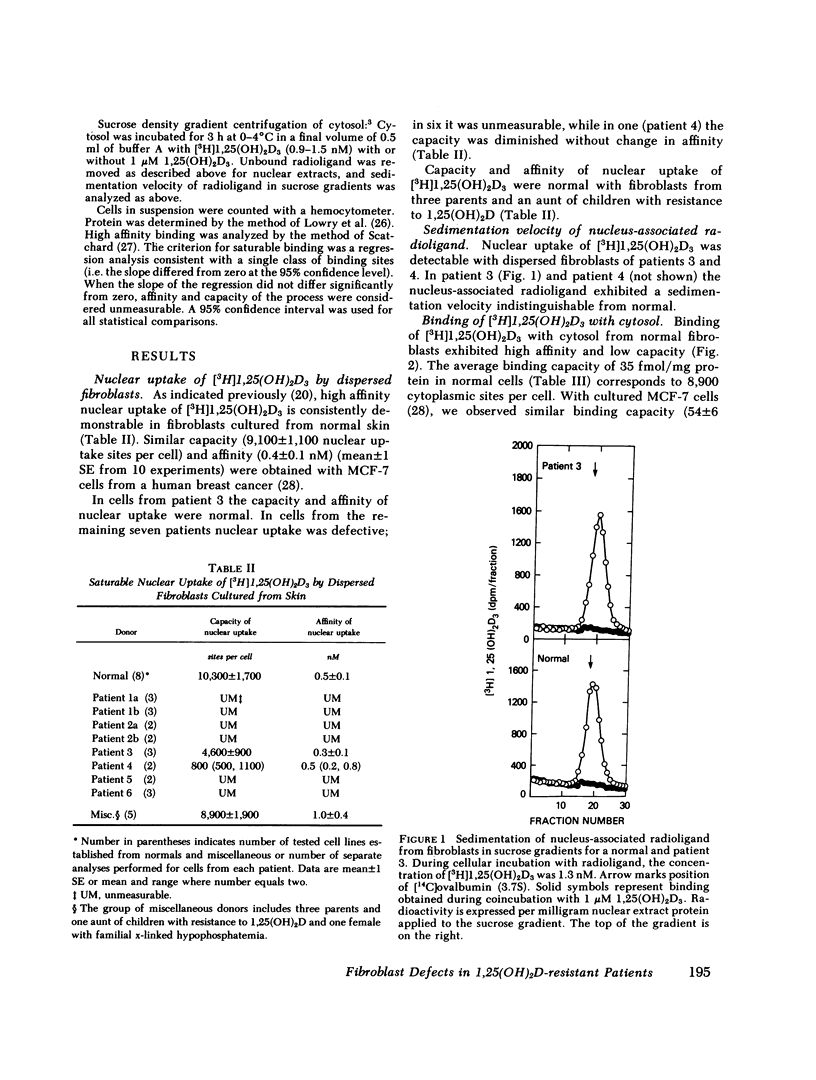
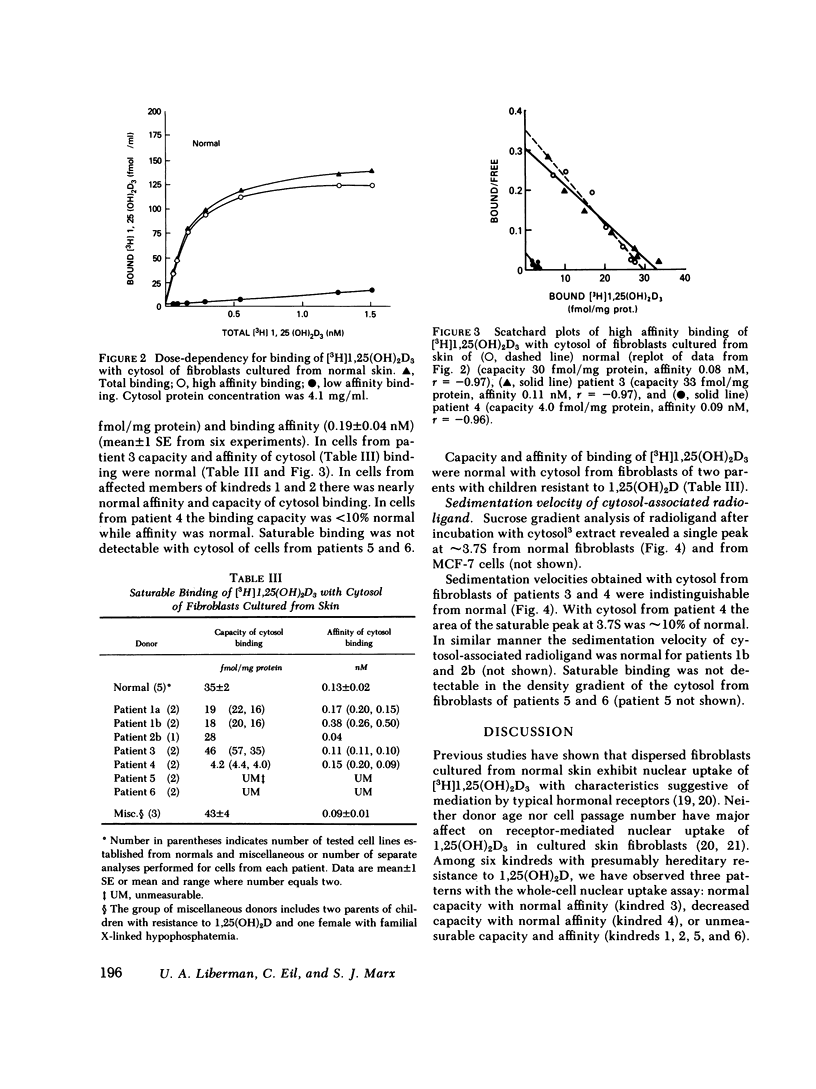
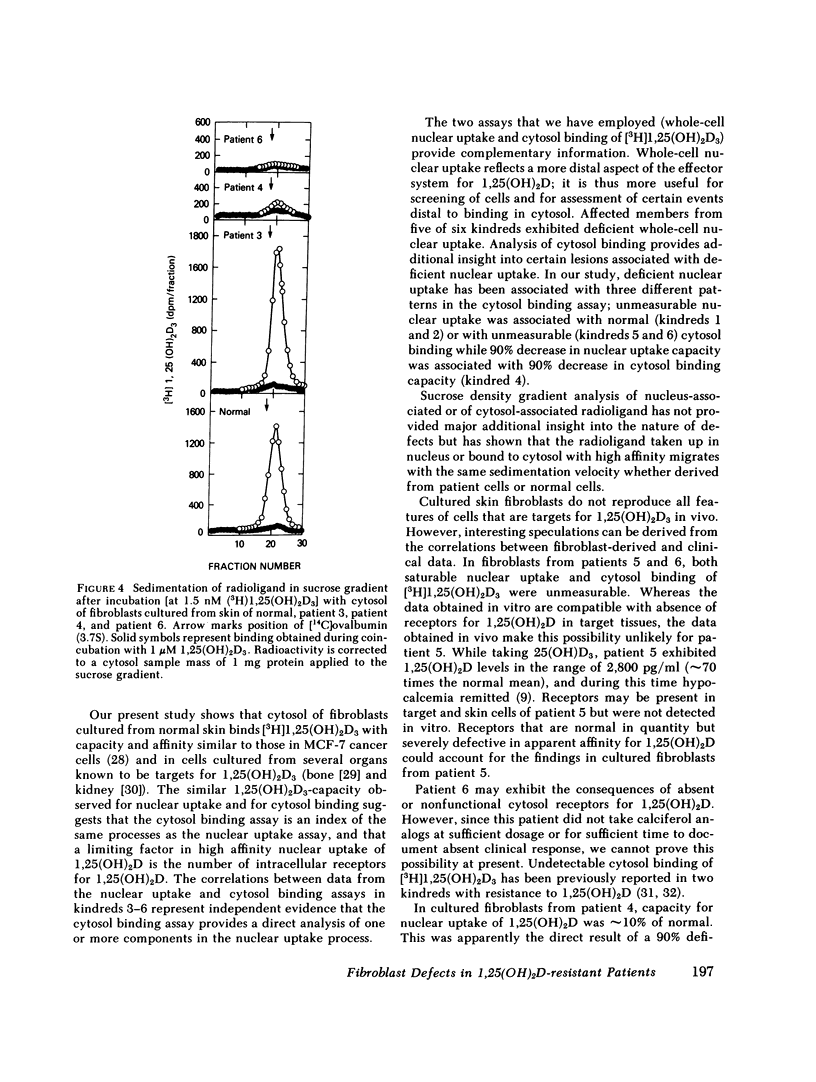
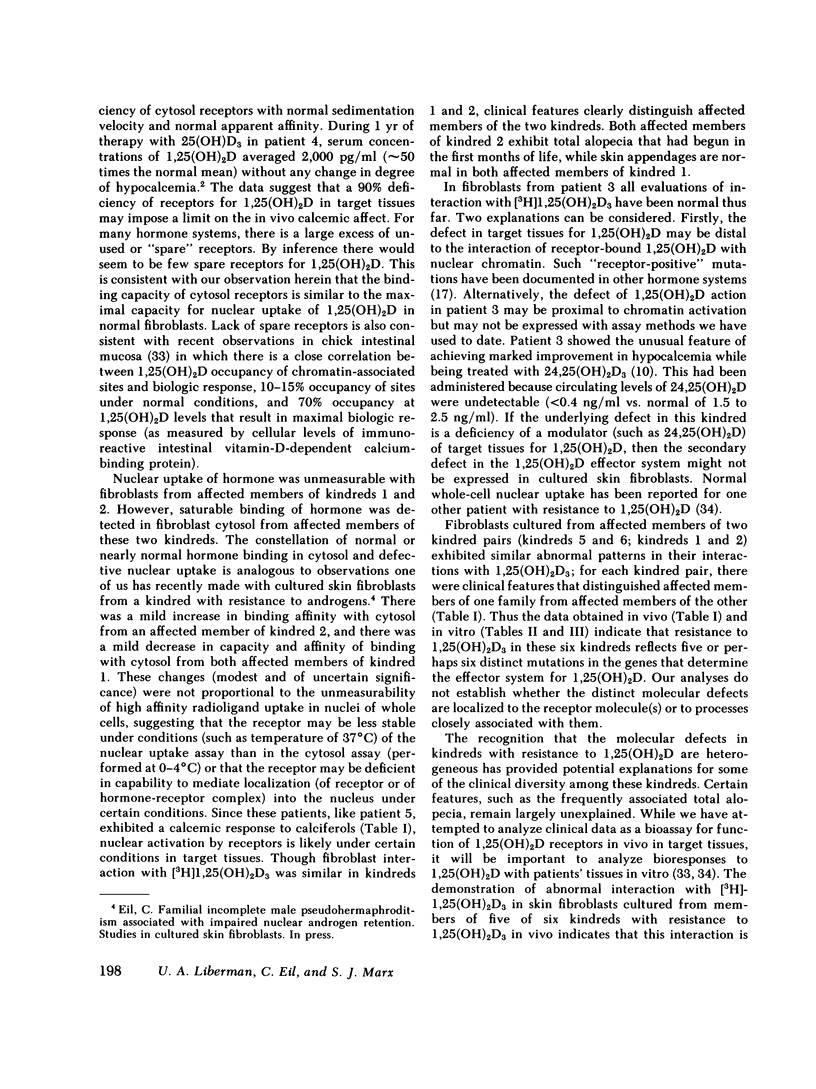
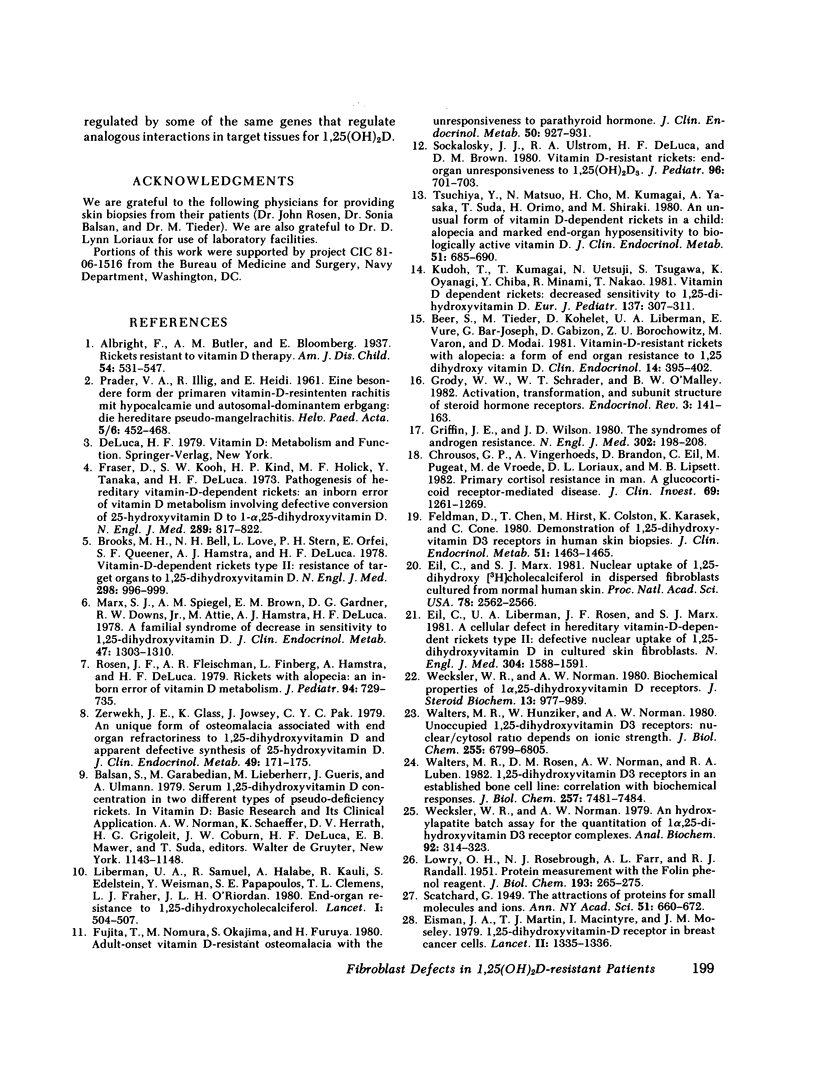
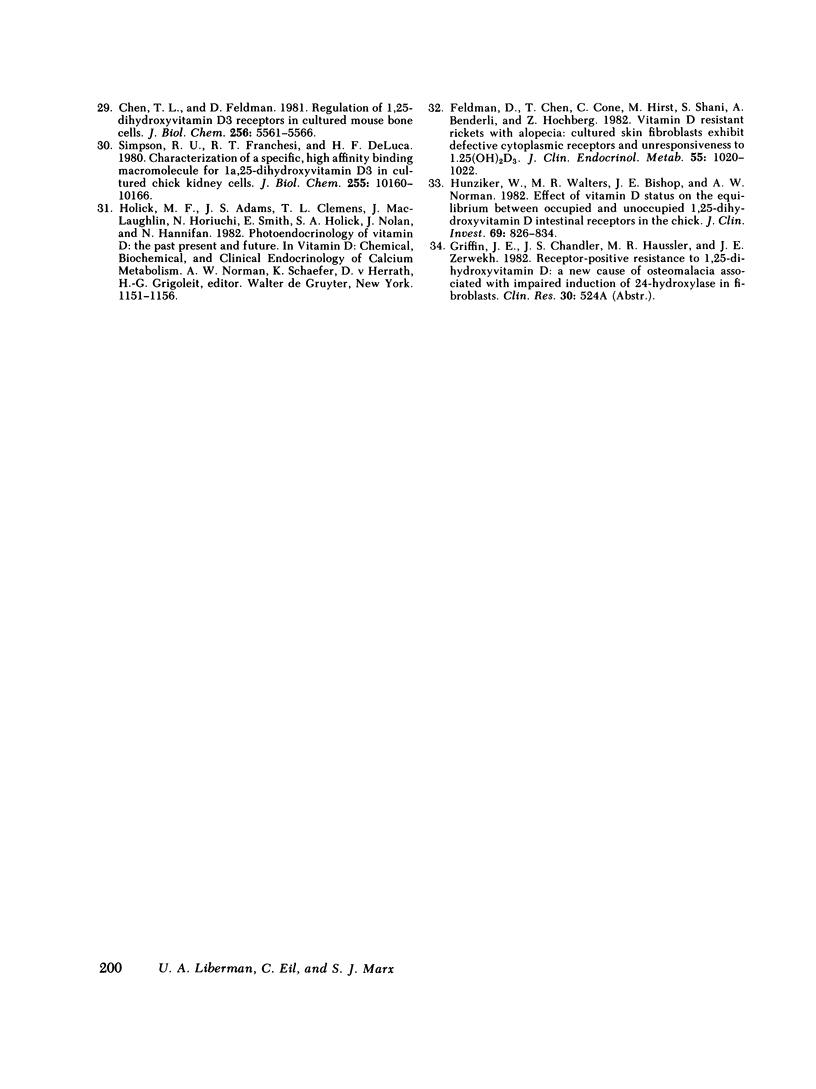
Selected References
These references are in PubMed. This may not be the complete list of references from this article.
- Beer S., Tieder M., Kohelet D., Liberman O. A., Vure E., Bar-Joseph G., Gabizon D., Borochowitz Z. U., Varon M., Modai D. Vitamin D resistant rickets with alopecia: a form of end organ resistance to 1,25 dihydroxy vitamin D. Clin Endocrinol (Oxf) 1981 Apr;14(4):395–402. doi: 10.1111/j.1365-2265.1981.tb00626.x. [DOI] [PubMed] [Google Scholar]
- Brooks M. H., Bell N. H., Love L., Stern P. H., Orfei E., Queener S. F., Hamstra A. J., DeLuca H. F. Vitamin-D-dependent rickets type II. Resistance of target organs to 1,25-dihydroxyvitamin D. N Engl J Med. 1978 May 4;298(18):996–999. doi: 10.1056/NEJM197805042981804. [DOI] [PubMed] [Google Scholar]
- Chen T. L., Feldman D. Regulation of 1,25-dihydroxyvitamin D3 receptors in cultured mouse bone cells. Correlation of receptor concentration with the rate of cell division. J Biol Chem. 1981 Jun 10;256(11):5561–5566. [PubMed] [Google Scholar]
- Chrousos G. P., Vingerhoeds A., Brandon D., Eil C., Pugeat M., DeVroede M., Loriaux D. L., Lipsett M. B. Primary cortisol resistance in man. A glucocorticoid receptor-mediated disease. J Clin Invest. 1982 Jun;69(6):1261–1269. doi: 10.1172/JCI110565. [DOI] [PMC free article] [PubMed] [Google Scholar]
- Eil C., Liberman U. A., Rosen J. F., Marx S. J. A cellular defect in hereditary vitamin-D-dependent rickets type II: defective nuclear uptake of 1,25-dihydroxyvitamin D in cultured skin fibroblasts. N Engl J Med. 1981 Jun 25;304(26):1588–1591. doi: 10.1056/NEJM198106253042608. [DOI] [PubMed] [Google Scholar]
- Eil C., Marx S. J. Nuclear uptake of 1,25-dihydroxy[3H]cholecalciferol in dispersed fibroblasts cultured from normal human skin. Proc Natl Acad Sci U S A. 1981 Apr;78(4):2562–2566. doi: 10.1073/pnas.78.4.2562. [DOI] [PMC free article] [PubMed] [Google Scholar]
- Eisman J. A., Martin T. J., MacIntyre I., Moseley J. M. 1,25-dihydroxyvitamin-D-receptor in breast cancer cells. Lancet. 1979 Dec 22;2(8156-8157):1335–1336. doi: 10.1016/s0140-6736(79)92816-2. [DOI] [PubMed] [Google Scholar]
- Feldman D., Chen T., Cone C., Hirst M., Shani S., Benderli A., Hochberg Z. Vitamin D resistant rickets with alopecia: cultured skin fibroblasts exhibit defective cytoplasmic receptors and unresponsiveness to 1,25(OH)2D3. J Clin Endocrinol Metab. 1982 Nov;55(5):1020–1022. doi: 10.1210/jcem-55-5-1020. [DOI] [PubMed] [Google Scholar]
- Feldman D., Chen T., Hirst M., Colston K., Karasek M., Cone C. Demonstration of 1,25-dihydroxyvitamin D3 receptors in human skin biopsies. J Clin Endocrinol Metab. 1980 Dec;51(6):1463–1465. doi: 10.1210/jcem-51-6-1463. [DOI] [PubMed] [Google Scholar]
- Fraser D., Kooh S. W., Kind H. P., Holick M. F., Tanaka Y., DeLuca H. F. Pathogenesis of hereditary vitamin-D-dependent rickets. An inborn error of vitamin D metabolism involving defective conversion of 25-hydroxyvitamin D to 1 alpha,25-dihydroxyvitamin D. N Engl J Med. 1973 Oct 18;289(16):817–822. doi: 10.1056/NEJM197310182891601. [DOI] [PubMed] [Google Scholar]
- Fujita T., Nomura M., Okajima S., Furuya H. Adult-onset vitamin D-resistant osteomalacia with the unresponsiveness to parathyroid hormone. J Clin Endocrinol Metab. 1980 May;50(5):927–931. doi: 10.1210/jcem-50-5-927. [DOI] [PubMed] [Google Scholar]
- Griffin J. E., Wilson J. D. The syndromes of androgen resistance. N Engl J Med. 1980 Jan 24;302(4):198–209. doi: 10.1056/NEJM198001243020404. [DOI] [PubMed] [Google Scholar]
- Grody W. W., Schrader W. T., O'Malley B. W. Activation, transformation, and subunit structure of steroid hormone receptors. Endocr Rev. 1982 Spring;3(2):141–163. doi: 10.1210/edrv-3-2-141. [DOI] [PubMed] [Google Scholar]
- Hunziker W., Walters M. R., Bishop J. E., Norman A. W. Effect of vitamin D status on the equilibrium between occupied and unoccupied 1,25-dihydroxyvitamin D intestinal receptors in the chick. J Clin Invest. 1982 Apr;69(4):826–833. doi: 10.1172/JCI110522. [DOI] [PMC free article] [PubMed] [Google Scholar]
- Kudoh T., Kumagai T., Uetsuji N., Tsugawa S., Oyanagi K., Chiba Y., Minami R., Nakao T. Vitamin D dependent rickets: decreased sensitivity to 1,25-dihydroxyvitamin D. Eur J Pediatr. 1981 Nov;137(3):307–311. doi: 10.1007/BF00443263. [DOI] [PubMed] [Google Scholar]
- LOWRY O. H., ROSEBROUGH N. J., FARR A. L., RANDALL R. J. Protein measurement with the Folin phenol reagent. J Biol Chem. 1951 Nov;193(1):265–275. [PubMed] [Google Scholar]
- Liberman U. A., Samuel R., Halabe A., Kauli R., Edelstein S., Weisman Y., Papapoulos S. E., Clemens T. L., Fraher L. J., O'Riordan J. L. End-organ resistance to 1,25-dihydroxycholecalciferol. Lancet. 1980 Mar 8;1(8167):504–506. doi: 10.1016/s0140-6736(80)92763-4. [DOI] [PubMed] [Google Scholar]
- Marx S. J., Spiegel A. M., Brown E. M., Gardner D. G., Downs R. W., Jr, Attie M., Hamstra A. J., DeLuca H. F. A familial syndrome of decrease in sensitivity to 1,25-dihydroxyvitamin D. J Clin Endocrinol Metab. 1978 Dec;47(6):1303–1310. doi: 10.1210/jcem-47-6-1303. [DOI] [PubMed] [Google Scholar]
- PRADER A., ILLIG R., HEIERLI E. [An unusual form of primary vitamin D-resistant rickets with hypocalcemia and autosomal-dominant hereditary transmission: hereditary pseudo-deficiency rickets]. Helv Paediatr Acta. 1961 Dec;16:452–468. [PubMed] [Google Scholar]
- Rosen J. F., Fleischman A. R., Finberg L., Hamstra A., DeLuca H. F. Rickets with alopecia: an inborn error of vitamin D metabolism. J Pediatr. 1979 May;94(5):729–735. doi: 10.1016/s0022-3476(79)80139-0. [DOI] [PubMed] [Google Scholar]
- Simpson R. U., Franceschi R. T., DeLuca H. F. Characterization of a specific, high affinity binding macromolecule for 1 alpha, 25-dihydroxyvitamin D3 in cultured chick kidney cells. J Biol Chem. 1980 Nov 10;255(21):10160–10166. [PubMed] [Google Scholar]
- Sockalosky J. J., Ulstrom R. A., DeLuca H. F., Brown D. M. Vitamin D--resistant rickets: end-organ unresponsiveness to 1,25(OH)2D3. J Pediatr. 1980 Apr;96(4):701–703. doi: 10.1016/s0022-3476(80)80748-7. [DOI] [PubMed] [Google Scholar]
- Tsuchiya Y., Matsuo N., Cho H., Kumagai M., Yasaka A., Suda T., Orimo H., Shiraki M. An unusual form of vitamin D-dependent rickets in a child: alopecia and marked end-organ hyposensitivity to biologically active vitamin D. J Clin Endocrinol Metab. 1980 Oct;51(4):685–690. doi: 10.1210/jcem-51-4-685. [DOI] [PubMed] [Google Scholar]
- Walters M. R., Hunziker W., Norman A. W. Unoccupied 1,25-dihydroxyvitamin D3 receptors. Nuclear/cytosol ratio depends on ionic strength. J Biol Chem. 1980 Jul 25;255(14):6799–6805. [PubMed] [Google Scholar]
- Walters M. R., Rosen D. M., Norman A. W., Luben R. A. 1,25-Dihydroxyvitamin D receptors in an established bone cell line. Correlation with biochemical responses. J Biol Chem. 1982 Jul 10;257(13):7481–7484. [PubMed] [Google Scholar]
- Wecksler W. R., Norman A. W. An hydroxylapatite batch assay for the quantitation of 1alpha,25-dihydroxyvitamin D3-receptor complexes. Anal Biochem. 1979 Jan 15;92(2):314–323. doi: 10.1016/0003-2697(79)90664-x. [DOI] [PubMed] [Google Scholar]
- Wecksler W. R., Norman A. W. Biochemical properties of 1 alpha, 25-dihydroxyvitamin D receptors. J Steroid Biochem. 1980 Aug;13(8):977–989. doi: 10.1016/0022-4731(80)90173-9. [DOI] [PubMed] [Google Scholar]
- Zerwekh J. E., Glass K., Jowsey J., Pak C. Y. An unique form of osteomalacia associated with end organ refractoriness to 1,25-dihydroxyvitamin D and apparent defective synthesis of 25-hydroxyvitamin D. J Clin Endocrinol Metab. 1979 Aug;49(2):171–175. doi: 10.1210/jcem-49-2-171. [DOI] [PubMed] [Google Scholar]


